Intel Core i7 4960X (Ivy Bridge E) Review
by Anand Lal Shimpi on September 3, 2013 4:10 AM EST- Posted in
- CPUs
- Intel
- Ivy Bridge
- Ivy Bridge-E
Memory Performance
Seeing as how the huge L3 cache and quad-channel memory interface are big parts of what makes Ivy Bridge E unique, I thought it might make sense to look at memory latency and bandwidth. We'll start with memory latency, compared to Ivy Bridge, Haswell and Haswell + Crystalwell.
The larger L3 cache buys IVB-E lower latency accesses for a wider range of addresses, but once you exceed the 15MB L3 cache space we see latency about on par with everything else. Only Haswell + Crystalwell manages to hold out for longer. Unfortunately that's not really a part desktop enthusiasts can buy so it's mostly an academic comparison.
The bandwidth story is an interesting one. Sandra maxes out bandwidth by driving all cores at the same time, so you get some uplift here by there simply being more cores under IVB-E's hood. But even if you divide out the number of cores, you get per core cache bandwidth figures that are extremely high (at least outside of L1). The L3 cache in particular is quite bandwidth happy.
Going outside of the L3 cache, we also see a doubling of memory bandwidth - which is expected given the doubling of memory interface width. In reality the peak memory bandwidth advantage would be even larger as IVB-E officially supports DDR3-1866 (if you only populate 1 DIMM per channel, otherwise either 1333 or 1600 is officially supported).
General Performance
I don't know that I've ever seen an Intel slide before that called out a performance degradation, but there's a first time for everything:
The problem with IVB-E vs. Haswell is that the extra large L3 cache and quad-channel memory interface are generally only useful in heavily threaded applications, which of course benefit from its 6-core configuration. In those tests that aren't heavily threaded however, IVB-E typically sees a single threaded performance deficit compared to Haswell. Given that the 4960X and Haswell based Core i7-4770K run at very similar frequencies, it's not surprising to see IVB-E take a backseat to Haswell in in "everyday computing" tasks. Intel's slide above claims about a 18% reduction in "everyday computing" performance compared to the 4770K, but in practice I found the gap to be much narrower.
Although not the best indication of overall system performance, the SYSMark 2012 suite does give us a good idea of lighter workloads than we're used to testing.
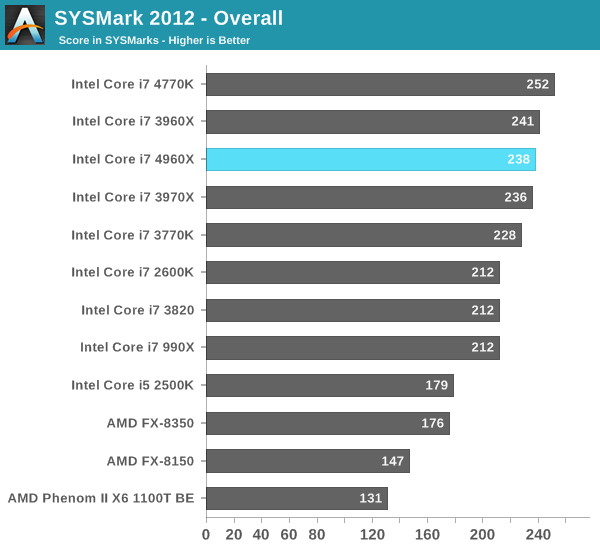
There's pretty much no advantage to the 4960X over the 3970X here. Remember Ivy Bridge's architectural improvements were very limited on the CPU side. As clock speeds didn't really go up between the 3970X and 4960X, the performance parity here isn't surprising. Haswell manages a ~6% performance advantage over the 4960X at an obviously lower power and price point.
Although I retired SYSMark 2007 a while ago, I do have much older performance data here which lets us compare the 4960X back as far as the early Pentium 4 based Extreme Edition parts:
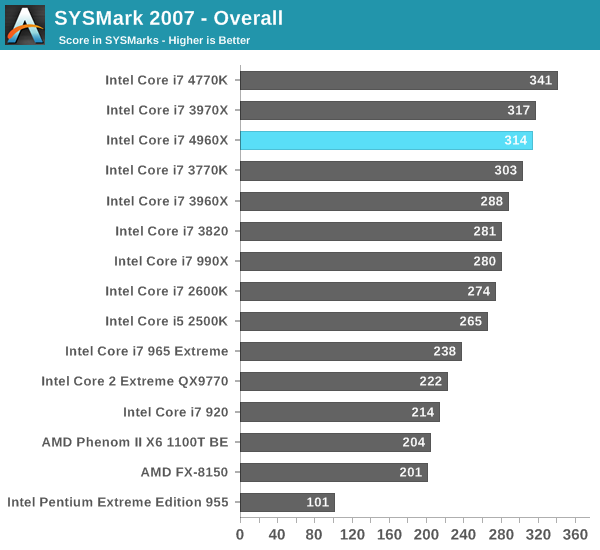
The Haswell advantage grows a bit here to around 8%, but the 4960X remains in the top three performers here. It's very clear that for most users, there are far more cost effective ways of getting great performance than IVB-E.
Our final lightly threaded test is Mozilla's Kraken JavaScript benchmark. This test includes some forward looking js code designed to showcase performance of future rich web applications on today's software and hardware. We run the test under IE10:
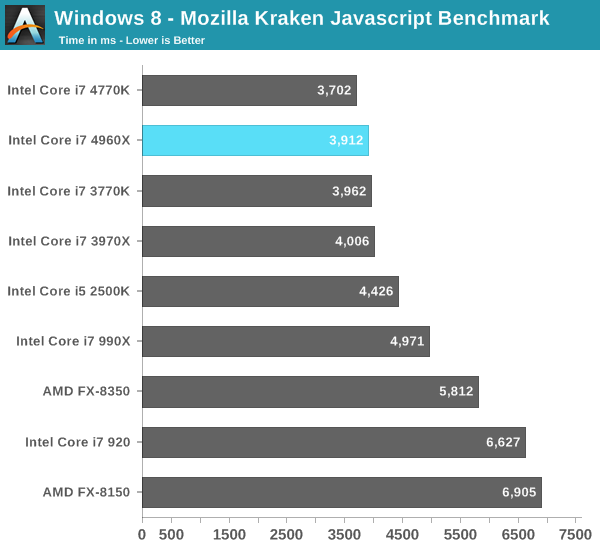
Ivy Bridge always had good single threaded performance, but once again these lightly threaded use cases are better served by an architecture with higher IPC. The Haswell advantage isn't huge, but it's a lower power/more cost effective way to get the best performance here.
If you are still on LGA-1366, you'll note that the performance gains here are good, but not earth shattering. Comparing to Intel's first 6-core platform, the 4960X manages a 27% increase in performance over the Core i7-990X. That's a healthy gain, but it's still small enough where there's no immediate need to upgrade.


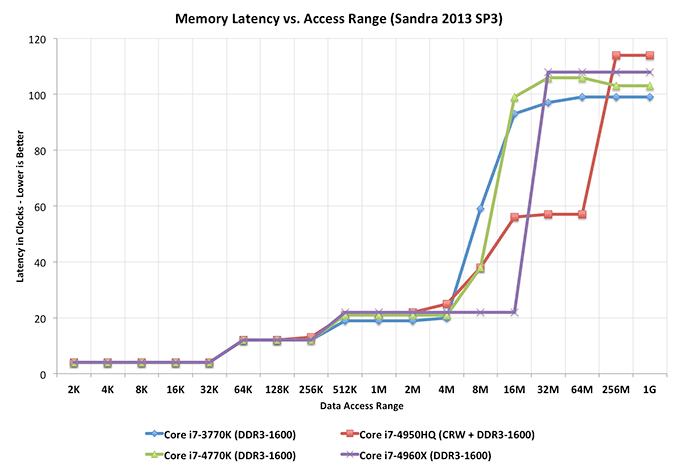
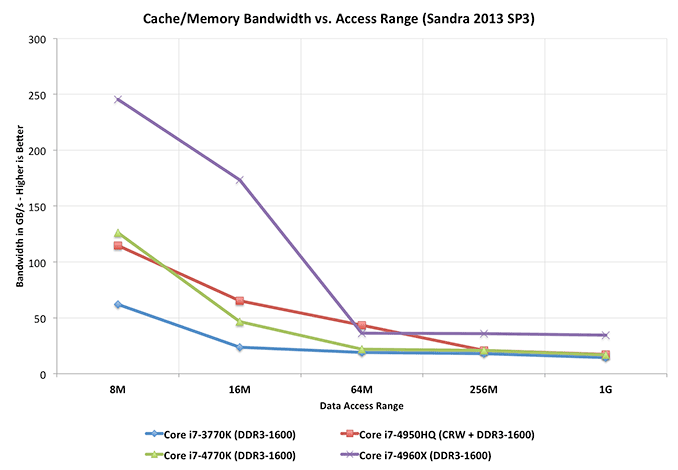
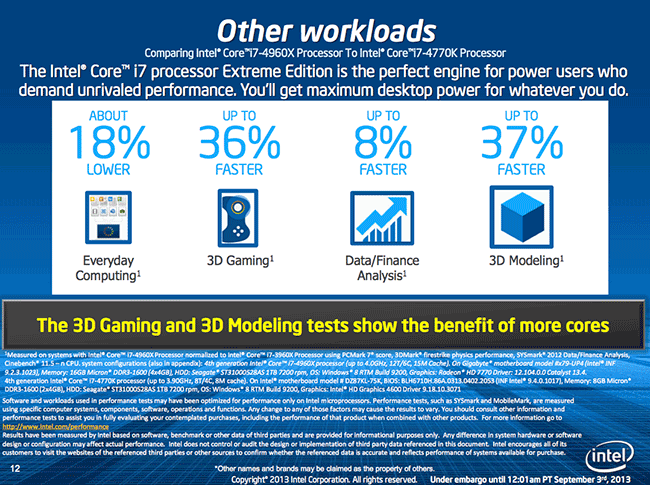








120 Comments
View All Comments
Kevin G - Wednesday, September 4, 2013 - link
I believe the only way to get a specially binned or configured chip from Intel is to be an OEM and order a large volume. For an unlocked Xeon, the only chance Intel would release such a system would be under contract for a super computer contract that also used liquid cooling.OEM's like HP, Dell and Apple can also acquire specifically binned chips for a premium if the OEM wants something better or for a discount if Intel has excess inventories of low grade chips they need to sell.
1Angelreloaded - Tuesday, September 3, 2013 - link
Apple was the one who petitioned Intel to put the GPU on Die, so they could get away selling at higher prices with a lower cost to them. Do like I do BLAME APPLE.colonelclaw - Tuesday, September 3, 2013 - link
In conclusion, if you're an enthusiast who wants a high core count, Xeon is your only choice. For the price of the top-end Xeon you can buy a pretty decent second-hand car!We really need AMD to get back into the high-end game.
f0d - Tuesday, September 3, 2013 - link
yeah cpu's were much better when amd competed in the high endlets just hope they can pull a good one out of somewhere
Casper42 - Tuesday, September 3, 2013 - link
Hate to burst your bubble but AMD is going through a bit of a reset right now.Opteron 6400s in 2014. Minimal increase in performance.
Next Gen Ground Up architecture is 2015, or when you get your AMD rep drunk at a trade show, you hear more likely 2016. If they can pull it off, this is where they will become a player again.
Most of their attention at the moment is Trinity style APUs with minimal Core Counts just like Intel's desktop stuff.
DG4RiA - Tuesday, September 3, 2013 - link
When are these E5 V2 Xeons gonna be out ? Why release this first instead of the new Xeons ?Hardly any performance increase after 22 months. I get that they want to be able to sell the 12-cores Xeon for three grands instead of one, but why can't they just add two extra cores to 4960X instead of just adding 200MHz ?
Casper42 - Tuesday, September 3, 2013 - link
E5-2600 v2 is next week, Septh 10thE5-4600 v2 and E5-2400 v2 will be very end of 2013 or early 2014.
E7 (Ivy EX) will also be like January 2014. 15 cores is what I am hearing there.
DG4RiA - Wednesday, September 4, 2013 - link
Thanks for the info. I'm looking at dual socket build, so hopefully these V2 Xeon is worth the wait.Shadowmaster625 - Tuesday, September 3, 2013 - link
Intel is so greedy. They could have made this chip 10 core / 20 thread and the die size still would have been less than SNB-E. For a high end part, a chip this small is just a slap in the face. I hope their greed costs them lots of $$.ShieTar - Tuesday, September 3, 2013 - link
Sure. Also, the TDP at close to 4 GHz would have been 220W. And the majority of customers would have tried to overclock them and drive 300W through them. And either complained because they damage too easily, or because of the lousy overclocking potential.